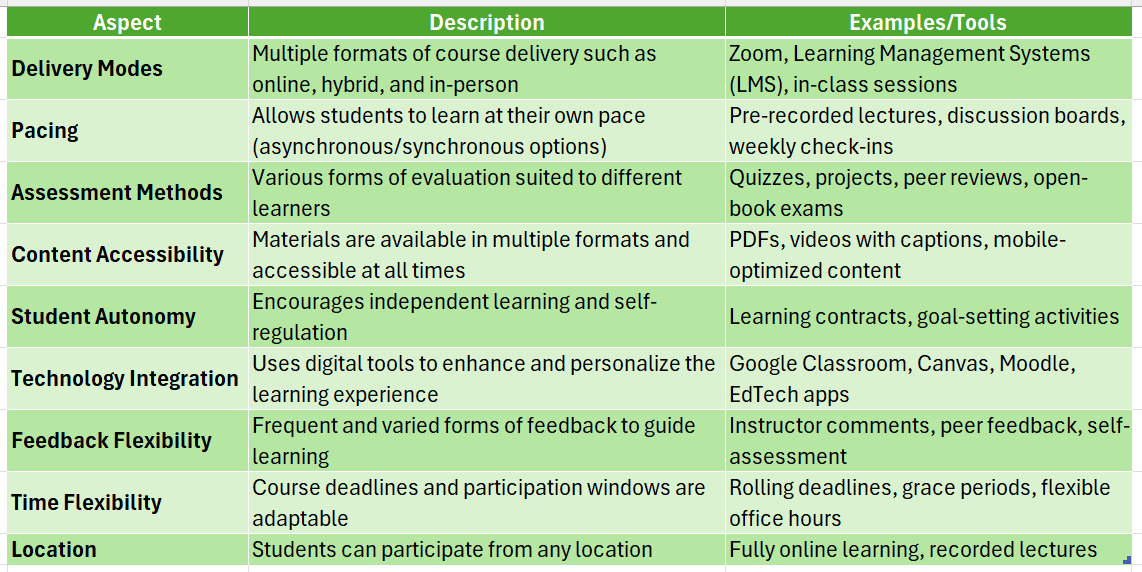
Flexible teaching is vital in today’s dynamic classroom environment. As students’ needs change, teachers must adapt their methods to ensure effective learning for all. This approach enhances student engagement and fosters a supportive atmosphere where every voice is valued.
What is Flexible Teaching?
Flexible teaching involves adjusting your style to meet diverse student needs, including:
- Community-based instruction: Linking lessons to real-world experiences.
- Teacher-centered instruction: Emphasizing the teacher’s expertise while promoting student participation.
This adaptability creates an inclusive classroom where all students can succeed.
Why is it Important?
Flexible teaching is crucial as it allows educators to address various learning styles and challenges. By embracing flexibility, teachers can:
- Improve student outcomes.
- Foster collaboration among peers.
- Encourage critical thinking and problem-solving skills.
Ultimately, it prepares students for a dynamic world, making learning relevant and engaging.
Key Benefits of Flexible Teaching
This approach offers numerous advantages:
- Increased Engagement: Tailored lessons boost student participation.
- Diverse Learning Opportunities: Various methods cater to different learning styles, ensuring comprehension.
How to Implement Flexible Teaching
To implement flexible teaching effectively:
- Assess Student Needs: Regularly check in with students.
- Diversify Instructional Methods: Use a mix of lectures, group work, and hands-on activities.
- Encourage Feedback: Foster an open environment for student input.
In conclusion, flexible teaching is essential in modern education, creating effective and enjoyable learning experiences.
Study smarter, not harder—Enroll online today!
Why Flexibility is Key in Modern Classrooms

In today’s fast-paced world, classrooms are constantly evolving. This is where flexible teaching comes into play. It’s not just about sticking to one method; it’s about adapting to what students need. When teachers embrace flexibility, they can create a learning environment that meets diverse needs, making education more effective and engaging.
Adapting to Student Needs
Flexible teaching allows educators to shift their methods based on students’ strengths and weaknesses. For instance, if a student struggles with traditional learning, a teacher can switch to community-based instruction. This approach connects lessons to real-life experiences, making learning more relatable and impactful.
Benefits of Flexibility
- Engagement: Students are more likely to participate when lessons are tailored to their interests.
- Inclusivity: Flexible teaching accommodates different learning styles, ensuring everyone has a chance to succeed.
- Growth: Teachers can refine their strategies, enhancing their effectiveness over time.
Incorporating teacher-centered instruction also plays a crucial role. It empowers teachers to lead discussions, guiding students through complex topics while still allowing for flexibility in how lessons are delivered. Ultimately, flexibility in teaching isn’t just a trend; it’s a necessity for fostering a thriving learning environment.
Adapting to Diverse Learning Styles: Strategies for Success
Flexible teaching is essential in today’s classrooms, where students come with diverse backgrounds and learning styles. Adapting methods to meet these changing needs not only enhances student engagement but also fosters a supportive learning environment. By embracing flexible teaching, educators can create a space where every student feels valued and understood.
Understanding Different Learning Styles
Every student learns differently. Some may thrive in a teacher-centered instruction setting, while others benefit from community-based instruction. Recognizing these differences is the first step toward effective flexible teaching.
Strategies for Implementation
- Incorporate Variety: Use a mix of lectures, group work, and hands-on activities to cater to various learning preferences.
- Encourage Collaboration: Foster a community-based instruction approach by allowing students to work together, sharing their unique perspectives.
- Provide Choices: Give students options in assignments or projects, empowering them to engage in ways that resonate with their learning style.
By implementing these strategies, teachers can create a dynamic classroom environment. This not only helps students succeed academically but also builds their confidence and social skills. Remember, flexible teaching is about meeting students where they are and guiding them to where they can be.
How Technology Enhances Flexible Teaching Practices
In today’s dynamic classroom environment, flexible teaching is essential for meeting diverse student needs. By leveraging technology, educators can enhance learning experiences, ensuring every student has the chance to succeed.
Embracing Community-Based Instruction
Technology allows teachers to connect with their community in real-time. For example, virtual field trips can make local history engaging and relevant, fostering a sense of belonging among students.
Supporting Teacher-Centered Instruction
Tools like interactive whiteboards enable teachers to switch between various teaching styles easily. This flexibility helps focus on student needs, whether through direct instruction or collaborative projects, creating a dynamic classroom atmosphere.
Key Benefits of Technology in Flexible Teaching
- Personalized Learning: Tailors lessons to individual student needs, allowing everyone to learn at their own pace.
- Increased Engagement: Interactive tools keep students motivated and interested.
- Collaboration Opportunities: Online platforms foster teamwork, even from different locations.
Adapting to Student Feedback
Technology enables quick feedback collection through surveys, allowing teachers to adjust methods in real-time. Listening to student voices is vital in flexible teaching.
Conclusion
Incorporating technology into flexible teaching not only enhances learning but also prepares students for a tech-driven future, creating a more inclusive environment.
Creating an Inclusive Environment: Meeting Every Student’s Needs
Creating an inclusive environment is essential in today’s classrooms. Flexible teaching allows educators to adapt their methods to meet the diverse needs of every student. This approach not only enhances learning but also fosters a sense of belonging among students, making them feel valued and understood.
Understanding Flexible Teaching
Flexible teaching involves adjusting instructional strategies to cater to different learning styles. By incorporating community-based instruction, teachers can connect lessons to real-world experiences, making learning more relevant and engaging. This method encourages collaboration and helps students see the value in their education.
Benefits of an Inclusive Environment
- Engagement: Students are more likely to participate when lessons resonate with their interests.
- Support: Tailoring instruction provides support for students who may struggle with traditional methods.
- Growth: An inclusive classroom promotes personal growth and confidence in all learners.
Incorporating teacher-centered instruction can also help in creating a structured yet flexible environment. By balancing direct teaching with opportunities for student input, educators can ensure that all voices are heard, leading to a richer learning experience.
Study smarter, not harder—Enroll online today!
Assessing Student Progress: Flexible Methods for Evaluation
In today’s ever-changing classroom environment, flexible teaching is essential. It allows educators to adapt their methods based on student needs, ensuring everyone has the opportunity to succeed. This adaptability is crucial for fostering a supportive learning atmosphere, where students feel valued and engaged.
Understanding Student Needs
To effectively assess student progress, teachers can use a variety of flexible methods. These methods can include community-based instruction, where learning happens outside the traditional classroom. This approach not only makes learning more relevant but also allows students to apply their skills in real-world situations.
Diverse Evaluation Techniques
- Formative Assessments: Quick quizzes or group discussions help gauge understanding regularly.
- Peer Reviews: Students can learn from each other by providing feedback on assignments.
- Project-Based Learning: This encourages creativity and critical thinking, allowing students to showcase their knowledge in unique ways.
By incorporating these flexible teaching strategies, educators can better understand their students’ progress and adapt their instruction accordingly. This teacher-centered instruction ensures that every student receives the support they need to thrive.
The Role of Collaboration in Flexible Teaching
Flexible teaching is essential in today’s classrooms, where students have diverse needs and learning styles. By adapting methods, teachers can create an environment that fosters engagement and understanding. One key aspect of this adaptability is collaboration, which plays a vital role in enhancing the learning experience.
Building a Supportive Community
Collaboration encourages a sense of community among students. When they work together, they learn from each other, making community-based instruction more effective. This approach not only boosts confidence but also helps students feel valued and connected.
Teacher-Centered Instruction
Teachers can also benefit from collaboration. By sharing ideas and strategies, they can refine their teacher-centered instruction. This exchange of knowledge allows educators to adapt their methods, ensuring they meet the changing needs of their students.
Key Benefits of Collaboration
- Enhanced Learning: Students gain different perspectives.
- Increased Engagement: Working together makes learning fun.
- Shared Resources: Teachers can pool materials and ideas.
In conclusion, collaboration is a cornerstone of flexible teaching. It empowers both students and teachers to thrive in a dynamic learning environment.
How Scholarship.Education Supports Educators in Implementing Flexible Teaching
Flexible teaching is essential in today’s classrooms, where students have diverse needs and learning styles. Adapting methods not only enhances engagement but also fosters a supportive learning environment. This is where Scholarship.Education steps in, providing educators with the tools they need to implement flexible teaching effectively.
Tailored Resources
- Community-based instruction: Scholarship.Education offers resources that connect classroom learning to real-world experiences, making lessons more relevant and engaging for students.
- Teacher-centered instruction: Educators can access strategies that empower them to lead discussions and activities that cater to individual student needs, ensuring everyone has a voice.
Professional Development
- Workshops and Training: Scholarship.Education provides workshops that focus on flexible teaching strategies, helping teachers learn how to adapt their methods in real-time.
- Collaborative Learning: Educators can share experiences and tips, creating a community that supports each other in implementing flexible teaching practices effectively.
By utilizing these resources, teachers can create a dynamic classroom environment that meets the changing needs of their students, making learning both fun and effective.
Study smarter, not harder—Enroll online today!
FAQs
1. What is flexible teaching?
Flexible teaching is an instructional approach that allows for adaptability in how, when, and where learning occurs. It often includes a mix of in-person, online, and hybrid formats to accommodate diverse student needs.
2. How is flexible teaching different from traditional teaching?
Traditional teaching typically follows a fixed schedule and format, often in-person. Flexible teaching, on the other hand, allows for varied formats (asynchronous, synchronous, hybrid) and adaptable learning paths.
3. What are the benefits of flexible teaching for students?
Students gain greater control over their learning pace, location, and schedule. This approach supports work-life balance, accessibility, and accommodates different learning styles.
4. What technologies are used in flexible teaching?
Common tools include learning management systems (like Canvas or Blackboard), video conferencing platforms (Zoom, Microsoft Teams), digital content, discussion forums, and collaboration tools like Google Workspace.
5. Can flexible teaching be as effective as face-to-face instruction?
Yes, when well-designed, flexible teaching can be equally or even more effective by offering personalized learning opportunities, real-time feedback, and increased engagement through diverse formats.
6. What challenges do instructors face with flexible teaching?
Instructors may face challenges such as increased planning time, managing different learning modalities simultaneously, and ensuring all students remain engaged and supported.





